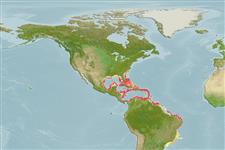Classification / Names
Common names | Synonyms | Catalog of Fishes (gen., sp.) | ITIS | CoL | WoRMS | Cloffa
Actinopterygii (ray-finned fishes) >
Perciformes (Perch-likes) >
Serranidae (Sea basses: groupers and fairy basslets) > Epinephelinae
Environment / Climate / Range
Ecology
Marine; demersal; depth range 90 - 360 m (Ref. 89707). Subtropical, preferred 27°C (Ref. 107945); 36°N - 28°S, 98°W - 34°W (Ref. 5222)
Western Atlantic: North Carolina, USA to southern Brazil, including Gulf of Mexico and the Caribbean.
Length at first maturity / Size / Weight / Age
Maturity: Lm ?, range 58 - ? cm
Max length : 115 cm TL male/unsexed; (Ref. 5222); common length : 50.0 cm TL male/unsexed; (Ref. 5217); max. published weight: 18.6 kg (Ref. 40637); max. reported age: 35 years (Ref. 36872)
Dorsal
spines
(total): 11;
Dorsal
soft rays
(total): 13-15;
Anal
spines: 3;
Anal
soft rays: 9. Distinguished by the following characteristics: buff or greyish brown head and body, whitish ventrally; yellow margins of dorsal and pectoral fins, sometimes including anal and caudal fins; pale blue line from the eye to the angle of preopercle; depth of body less than head length, contained 2.7-2.9 times in SL; head length 2.4-2.6 times in SL; convex interorbital area; angular preopercle, serrae at the angle distinctly enlarged; eye diameter equal to or greater than interorbital width in fish less than 45 cm SL; posterior and anterior nostrils subequal in size (Ref. 89707).
A solitary species (Ref. 26340) occurring in rocky areas and on sand mud bottom. On soft bottoms they are often seen in or near trenches or burrow-like excavations. Feeds on a wide variety of invertebrates (mainly brachyuran crabs) and fishes. Marketed fresh and considered good quality.
Life cycle and mating behavior
Maturity | Reproduction | Spawning | Eggs | Fecundity | Larvae
Craig, M.T. and P.A. Hastings, 2007. A molecular phylogeny of the groupers of the subfamily Epinephelinae (Serranidae) with revised classification of the epinephelini. Ichthyol. Res. 54:1-17. (Ref. 83414)
IUCN Red List Status (Ref. 115185)
CITES (Ref. 94142)
Not Evaluated
Threat to humans
Harmless
Human uses
Fisheries: commercial; gamefish: yes
Tools
Special reports
Download XML
Internet sources
